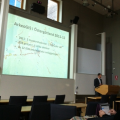ARKDIS project was a co-organiser of this year's Computer Applications and Quantitative Methods in Archaeology Sweden (CAA-SE) conference in Lund in December 2-4, 2013. We were altogether over 60 participants and had an interesting programme for three days. During the first two days we had paper presentations and two keynotes given by Philip Verhagen (Vrije Universiteit Amsterdam) and Sofia Pescarin (CNR ITABC). Philip discussed least cost path modelling and different aspects of travelling using two case studies from Low Countries and Cappadocia showing that there is plenty of work to do in this rather long-researched but highly under-theorised area. Sofia's talk gave a broad overview of the notions of virtual museum and various aspects pertaining to the the public presentation of archaeological virtual realities. The third day was reserved for a visit to Lund University Design Centre and Humanities Lab where the conference participants had an opportunity to acquaint themselves with the current projects of the Humanities lab.
The programme had a good spread of papers from senior researchers, doctoral students, professionals and master's students. Similarly, thematically the conference covered all covnetional CAA-themes from quantitative methods and GIS to 3D and data management and public presentations of archaeology. From my own point of view, it was interesting to hear updates from Marcus Smith from the National Heritage Board on the Digital Archaeological Processes Programme and Ulf Jakobsson on the work on the Swedish National Data Archive and their work on the archiving of archaeological research data. Other highlights were the 3d data capture and modelling related presentations given by the master's students of Lund University that really opened the technical issues related to capturing of 3d data and gave a promise of the diffusion of these methods to become a part of the everyday work practices of archaeologists in the future.
Bodil Petersson from the ARKDIS project discussed her and Carolina Larsson's work on exhibitions and exhibiting archaeology in collaborations with Kivik museum and in general the different aspects of combining art and communication of archaeology. One of the interesting observations of the presentation was the question whether artists and designers should be involved in the archaeological fieldwork already in the beginning of the investigation process rather than only after the archaeologists have in practice handed over their documentation to a museum.
Another ARKDIS presentation was given by Per Stenborg who discussed the implications and consequences of digital presentations. He presented a number of interesting questions on the capabilities of digital surrogates to replace physical artefacts and sites, and for instance their implications for the repatriation debates. A significant aspect of these types of questions is that they really help to understand the nature and role of digital surrogates, the significant aspects of cultural heritage objects and how they can be vastly different for different individuals and groups.


